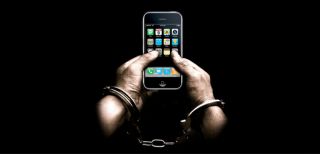
In the world today it’s clear that majority of society is dependent on technology in some way. Now a days, people tend to not leave the house without their smart-phones, a common habit especially among teens.
According to a study done by the Pew Research Center, 56% of all American adults own a smart-phone and younger younger adults—regardless of income level—are very likely to be smartphone owners. Most smart-phone owners can also relate to losing their phone, stressing over not being able to survive without on social media or play the latest new games for about five minutes, until they find their beloved phone again.

A restaurant displays a sign that reads, “Will give you 10% discount if you leave your phone in our custody and socialize.
Nomophobia-as inno– mo(bile) phone-phobia– that rush of anxiety and fear when you realize you are disconnected- out of the loop with friends, family, work and the world. Anything can be abused, even smart-phones. You yourself may have noticed that people are constantly on their phones, in a waiting room to a doctors office, eating lunch at a cafe, or just in class while the teacher is talking. While it is unsure whether or not the fear of not having your phone should be classified as an actual problem, it definitely feels like a real phobia for some people.
Maybe you’ve noticed you have spent a lot of more time on your phone than talking to your parents, but that doesn’t mean you have an addiction, right? Here are four potential signs of a phone addiction: panicking when you misplace your phone, on your phone in the presence of family or social situations, carrying your phone everywhere (even the bathroom) and waking up to check your phone immediately. Surely most people do at least a couple of these, or maybe all, but they seem to be perfectly fine. After all, different factors play into why some people may check their phone, it could be for someone they like or for a fan account of their favorite celebrity. It’s simply factoring out what’s healthy and what isn’t.
There may not be a direct cure to the obsession of a phone but some things you can do to alleviate your urge is to turn it on silent in public areas and turn off direct notifications. This can simply remove any excessive distractions that are keeping you from socializing with your peers.
As our culture becomes more tech savvy and tech hungry, “phone-free zones” will become more common. Just like “no-smoke zones” which can be found at nearly any restaurant, where in earlier times a restaurant would have welcomed smoking. During the time when smoking was permitted, it was allowed because people didn’t know the effects of smoking. The same can be said for smart-phone use.
“A few years ago, my mother instituted the no phones during dinner rule requiring all phones to be left in a different room,” explained Miss Simkovich, English Teacher at Colonia High. “If we are eating at a restaurant, phones are not permitted once we are seated because my mother feels it is more important to communicate face to face with the family around you. It isn’t so bad to put the phone down for an hour but I think I eat faster when I know I can’y look at the phone until I’m done eating,” noted Simkovich.
Richard Gray, and other science correspondents, conducted an international experiment in 2011- nearly four in five students had significant mental and physical distress, panic, confusion and extreme isolation when forced to unplug from technology for an entire day.
“Hearing that dink of a new message is enticing when driving,” explained Miss Chen, Math teacher, “but there are so many apps now to prevent texting and driving that I think not too many people use.” Chen also noted that certain jobs and skills are becoming obsolete because of the technology. For example, not too many people know how to read a map these days because society has mapquest and googlemaps.
In four years, we’ve advanced from the iPhone 3G to iPhone 6+. Imagine the amount of people in this day and age that can no longer go without their phone, regardless of their age. We can only stick around and see what awaits for our future and how technology will affect it.










